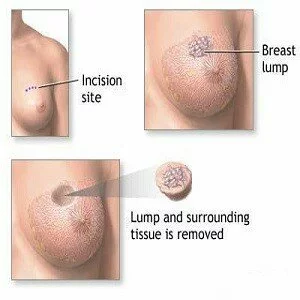Breast cancer is the commonest cancer in women, with over one million women developing breast cancer world-wide every year.
While it also affects men, the number is quite small compared to women. In the developed world where records are better kept, it is said that one in nine women is likely to develop breast cancer in her life time.
The good news is that breast cancer is a very treatable cancer; the cure rate is very high. Below are the available treatment regimes and the possible sequence of treatment. The treatment adopted is usually dependent on the stage of the cancer, the type of cancer and the wish of the patient.
1.Surgery
The commonest treatment for breast cancer is surgery; this could involve just removal of the tumour and the surrounding tissue (lumpectomy) or removal of the whole breast (mastectomy) and the nodes in the armpit. The decision to do which of the two operations depends on the size of the tumour, the location of the tumour and the involvement or not of the lymph nodes in the corresponding armpit. The decision also depends on the choice of the patient for cosmetic reasons.
2.Radiotherapy.
This involves the use of x-rays to kill the cancer cells. It follows surgery, must follow removal of the tumour in the breast but may not follow the removal of the whole breast if there has been no spread to the nodes in the armpit.
The course of radiotherapy can last up to 3-6 weeks. It is associated with manageable side-effects.
3.Hormone Therapy.
Most forms of breast cancer depend on the female hormones (oestrogen and progesterone) for growth; consequently, disrupting the activities of these hormones puts a stop to the growth of the cancer cells.
Breast cancer cells are said to have receptor points—oestrogen receptors and progesterone receptors to which the hormone (oestrogen) gets attached to promote growth of cancer cells.
These hormones are produced in the body, hormone therapy therefore involves blocking the production of the hormones by the body or preventing the hormones from getting attached to the receptor points of the cancer cells. Drugs have been developed to achieve this.
In some cases of breast cancer, the ovaries can be removed or suppressed.
4.Chemotherapy
Chemotherapy involves the use of drugs to kill dividing or rapidly growing cancer cells, it does not stop the growth of cancer cells, it kills cancer cells. Many drugs are available for this purpose.
The decision to use chemotherapy or not depends on several factors including the age of patient, fitness of the patient, size of the tumour, spread of the cancer, grade of the cancer among others.
The side effects of chemotherapy are several, ranging from hair loss, low blood level, bleeding from the skin to low resistance to infections.
5.Biologic Therapy
Apart from hormone receptors on cancer cells, some of them may have growth factors called HER receptors; there are four of such HER receptors—HER 1,2,3 and 4. The most important of these is the HER 2.
About 15-20 percent of all breast cancers has HER 2 receptors and thus relies on HER 2 for growth. Drugs have been developed to prevent the attachment of HER 2 to HER 2 receptors and thus prevent growth of the cancer cells, this prevention leads to shrinking and death of the cancer cells.
6.Sequence of treatment.
Treatment usually stars with surgery, followed by radiotherapy and then drug treatment to kill any cancer cells in other parts of the body.
However this sequence is not cast in stone, sometimes chemotherapy follows or precedes surgery which takes place before radiotherapy.




No Comments